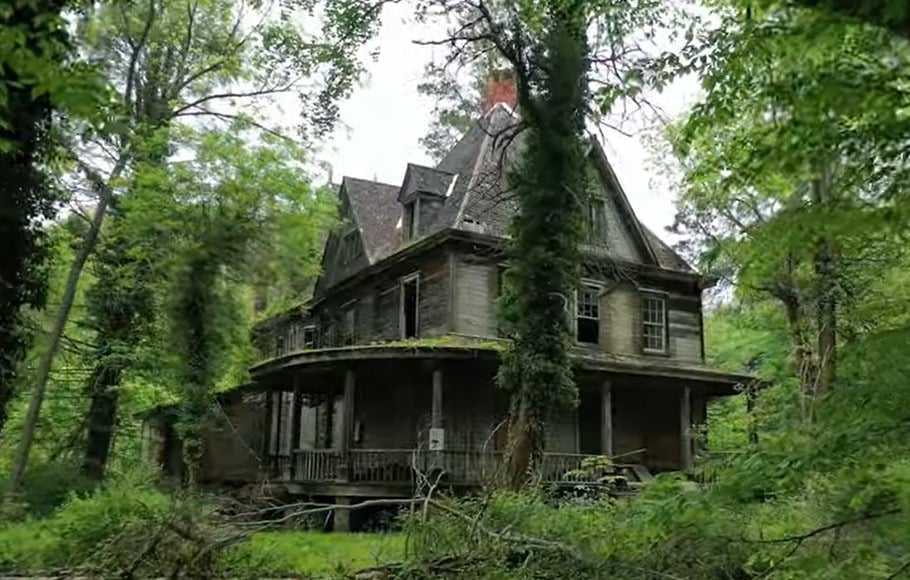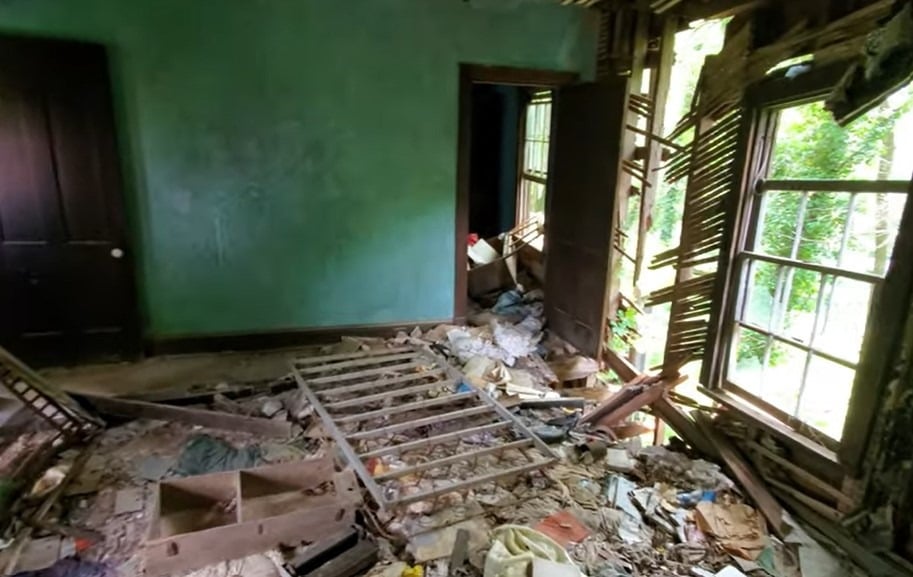Previously: Fairfield State Hospital.
Not too far away from Washington, D.C. lies Boyds, Maryland. An unincorporated community in Montgomery County, it was long known as a primarily rural area; that’s changed a bit in recent decades, of course, but Boyds’ past is still very much visible in its present. Some of it, however, is less visible — that is, you have to go off the beaten path, literally, in order to find it. If you look carefully, though, you might see the ruins of a once-grand Victorian manor home peeking back through the trees near Little Seneca Lake. The abandoned Winderbourne Mansion, as it’s known, has been vacant for years, and its current state reflects its loneliness: Windows are boarded up; the stairs leading up to the porch have collapsed; and inside lies the detritus of many years of neglect.

It is owned by someone (so, y’know, don’t go exploring without permission). What’s more, it has been up for sale several times in recent memory. So although it’s abandoned right now, it might not always be — and, perhaps, it might one day be restored to its former glory.
Winderbourne Mansion was built either in the 1870s or 1880s; sources conflict, so it’s unclear which. It’s commonly stated that the house was constructed in 1884; however, 1878 and even as early as 1872 have been mentioned as dates in a handful of other sources, so the truth remains unknown.
[Like what you read? Check out Dangerous Games To Play In The Dark, available from Chronicle Books now!]
Regardless, what we do know is that the mansion was built not as a primary residence, but as a secondary one — a place for the wealthy Totten family to vacation at during the summer. Its proximity to Washington, D.C. made it convenient for Enoch Totten, formerly a colonel in the military and later an attorney; and its grandeur? That was thanks largely to Enoch’s wife, Mary Howe Totten, who had inherited quite a large sum of money thanks to her uncle, Elias Howe of the Howe sewing machine empire. Using these funds, the Totten family built their majestic, Queen Anne-style manse by the banks of Little Seneca Creek. They even named it in honor of Elias Howe: “Winderbourne” is derived from the “bobbin winder” — the mechanism on Howe’s sewing machine responsible for winding and evenly distributing thread as the stitches are sewn.
(Interestingly, the money came not from the success of Howe’s own machine — or rather, from sales of that machine — but from a court case he won against Isaac Singer of the Singer sewing brand. Howe’s machine featured a lockstitch design, for which he had been awarded a patent in 1846. When Howe discovered that Singer was making and selling a machine using the lockstitch design for which Howe held the patent, Howe took his competitor to court — and when he won, he was awarded the ability to collect royalties on literally every variety of lockstitch machine sold, from Singer’s and beyond. This is where the Howe fortune truly came from: Not the invention itself, but the court case at which the invention was the center.)
Winderbourne was, in a word, grand. Painted a delicate pink with darker, rose-colored trim, and shutters that were darker still, the Victorian confection stood three stories tall, covering more than 5,000 square feet in total. It had 12 rooms, a full-length attic, two cellars, and a number of distinct architectural details — a room suspended over the entrance foyer, for example, and hidden rain spouts that led to a cistern underground. It also boasted beautiful gardens in which the Totten family frequently entertained when they were in residence.
But alas, tragedy befell the family during the years they spent shuttling back and forth between the District and Boyds. At one point, it’s said, all three of the Totten children came down with typhoid, one of whom — a son, perhaps — died young from the illness. One of the surviving children, Edith, did grow up and go on to accomplish wonderful things; she became a doctor, well-respected in her field, and although she never married, it’s said she adopted a daughter all on her own. But it’s also said that Edith lost her only child young, as well, in an accident involving the banisters of Winderbourne’s ornate staircases. Edith herself would later suffer a sudden and unexpected cerebral hemorrhage shortly after giving a lecture at Johns Hopkins University in Baltimore; she died at the still relatively young age of 48.

Winderbourne was sold in 1929 to Edward and Beulah Pickrell, where they raised their two children, Edward Jr. and Paxton. Edward Jr. later inherited the property and continued to live there until his own death in 2004, at which point it was deposited into Paxton’s hands.
The remaining Pickrell began trying to sell the house, which was nominated for inclusion in the National Register of Historic Places back in 1978, in 2009 — but unfortunately, the house’s condition had deteriorated substantially over the years, so much so he’s subsequently had trouble finding a buyer. In 2009, the list price was $2 million; by 2010, it had dropped to $1.5 million; and in 2016, the last time it was on the market, the asking price was set at just shy of $900,000. Although real estate records indicate that the house was marked as pending, contingent with no kickout, at the end of August/early September of 2016, the sale doesn’t appear to have gone through; the mansion was subsequently delisted in 2017 and hasn’t been up for sale again since. It currently sits alone, tucked in amongst the grounds of Black Hill Regional Park, continuing to decay as each day goes by.
It’s perhaps worth noting that, because of the house’s history — particularly the stories surrounding the two dead children — some claim the place to be haunted. In some ways, that’s no surprise; this history is, after all, the same sort of history that frequently contributes to rumors of hauntings in old houses. This is particularly true of ornate mansions in the United States once owned by the country’s wealthiest families; for example, Sauer Castle in Kansas City, the Lemp Mansion in St. Louis, and the Marsh-Edwards House in Dixfield, Maine, all played host to similar tragedies—and, yes, they all have reputations for being haunted as well.
But Paxton Pickrell firmly refutes Winderbourne’s ghostly characterization. According to the Washington Post, he’s “still ticked off that in 2011 a real estate website included Winderbourne on a list of ‘the spookiest, creepiest old houses for sale in America.’” (For the curious, the piece in question is this one, published over at Curbed during the Halloween season that year.) Said Pickrell to WaPo, “That place to me was just a wonderful home.”
Besides, the history itself… may not actually be history, strictly speaking. Archivist and librarian Joshua Spellman of the podcast Crimes And Witch-Demeanors dug deep into the whole thing and found not only that many of the alleged “facts” couldn’t actually be confirmed, but also that many of them can be outright debunked, too.
The story about one of the Tottens’ sons dying of typhoid, for instance? That… may not necessarily be accurate. It’s frequently reported that the Tottens had three children, two boys and a girl. But what Spellman found — and which I was also able to confirm — is that there were actually four Totten kids. What’s more, it wasn’t a son that died; Howe Totten lived until the age of 71, while Gerald Howe Totten made it to 73. It was a daughter who met a young and untimely end — Alice Crosby Totten, who goes unmentioned in most of the (admittedly scant) writing on the family. According to Alice’s gravestone in the family plot at Rock Creek Cemetery, she died on Oct. 6, 1884 at the age of 15. I was unable to determine whether she died of typhoid, but regardless, she did not make it to adulthood.
I wonder whether the confusion about the total number of Totten children has something to do with a misinterpretation of other records. In 1880, according to that year’s U.S. Census, the immediate Totten family was made up of Enoch, Mary, and three children: Edith, born in 1879 and only a year old at the time; Howe, born in 1870 and about 10; and the oldest, Alice, born in 1869 and roughly 11 years old. Their primary residence was on I Street in Washington, D.C.
(I should note here that there’s also an “Anna Totten” listed as living with Mary and Enoch — but she wasn’t a Totten kid; she wasn’t even a kid at all: She was 38 years old at the time. Due to her description as “Sister” and the fact that her estimated birth date is 1842, I assume “Anna” is Melissa Anne Totten, who, per Find A Grave, was Enoch’s sister and born in 1842.)

The youngest Totten child, Gerald, was born in 1880 — presumably after the census had been completed — and was therefore only four years old in 1884, when Alice died. This means that by the time the next census was conducted, there would still have been three Totten children — just a different three. (Unfortunately, though, I wasn’t able to locate the Totten family in any later census records.)
What’s not clear to me is whether Alice died before the family began summering at Winderbourne or after, due to the conflicting dates of the mansion’s construction. If the house dates back to 1872 or 1878, then Alice definitely would have spent time in it before she died; however, if it dates back only to 1884, then she may or may not have, depending on whether the Tottens summered there that year.
And, of course, there’s also the matter of how, over time, the story of a Totten daughter dying morphed into the story of a Totten son dying, especially given that the only Totten sons lived well into old age. This may have something to do with the root source for the house’s history as it’s commonly repeated: Joshua Spellman notes that most of what’s known about the house seems to come from the 1978 National Register of Historic Places nomination document, which relies heavily on a “personal interview” conducted with one Hershey Ayton in Gaithersburg that same year. There’s no mention of who precisely Ayton was, and since the history in this document is based so strongly on this one, single interview, Spellman is justifiably skeptical of its accuracy. As he puts it:
“While I love oral histories and I think they’re great for personal experiences, preserving indigenous languages, and folklore, I do not believe they’re great for accurately recording events before your lifetime from another family. Now, perhaps Ayton was some type of authority on the subject and they have information we’re not privy to… that cannot be known. But, insofar as the documents available to me, since I cannot access a lot of paper records without visiting institutions in Maryland, it doesn’t seem like their accounts are wholly accurate.”
I did a little digging myself, as well, and while I wasn’t able to find out too much more about Ayton, his name does appear in another historical preservation document — this one geared towards establishing the Boyds Historic District. Like the Winderbourne Mansion document, the Boyds Historic District one is dated 1978 and references the same “personal interview” conducted with Ayton; however, there’s a note here about the interview that’s absent in the Winderbourne document: Ayton is identified as “long a friend of the Totten family, and a frequent visitor to their home, Winderbourne.” Born in 1902, he was about 76 years old when the interview was conducted; he died about six years later, in 1984, at the age of 82. He’s interred at Forest Oak Cemetery in Gaithersburg, according to Find A Grave.
Spellman is right in his assessment that oral histories, while useful in many ways, aren’t necessarily 100 percent reliable; memory is fallible, and when it comes to recording objective facts, humans just… don’t always remember things accurately. So, although we can acknowledge that, due to his status as a friend of the Totten family who apparently spent a pretty considerable amount of time with them at Winderbourne, Ayton did, in fact, have a certain amount of authority on the subject, it’s worth taking the interview with a grain of salt.
(The episode of Crimes And Witch-Demeanors on Winderbourne is excellent, by the way, as is the podcast itself. The podcast’s website can be found here, and both the audio of the Winderbourne episode and a written transcript can be found here. I highly recommend checking them out.)
For his part, Paxton Pickrell remains hopeful that Winderbourne will go to the right person eventually; as he told the Washington Post in October of 2016, “I cannot believe that there isn’t somebody out there who says, ‘If I fix this up, it truly will be like owning Mount Vernon.” But it’s going to take an awful lot of work to get it to that point: The real estate agent who was managing the Winderbourne listing at the time also spoke to WaPo, and as he put it, “It probably isn’t for the fainthearted, or somebody who wants to flip it. It’s going to take a very unique individual to buy it and restore it — or argue with the county that it needs to be torn down and replaced.”
In the meantime, though, it remains where it has always been. It sits quietly, tucked in amongst the trees, rusting cars parked outside and numerous artifacts still locked inside as the once-grand building falls to pieces.
Ruin or restoration: Who knows what the future might hold for Winderbourne Mansion?
***
Follow The Ghost In My Machine on Twitter @GhostMachine13 and on Facebook @TheGhostInMyMachine. And don’t forget to check out Dangerous Games To Play In The Dark, available now from Chronicle Books!
[Images via Crumbling Decay America/YouTube]
Leave a Reply